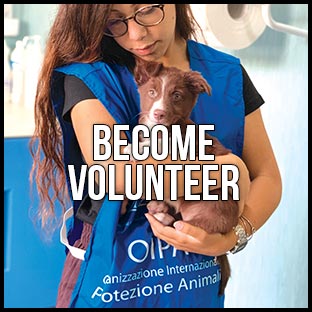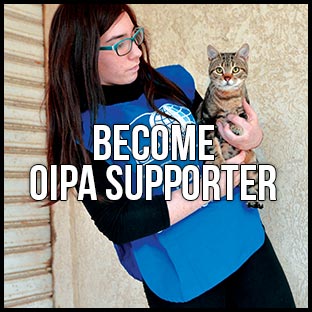
 THE CAPTURE
THE CAPTURE
Beaver, weasel, ermine, stone marten, wolverine, leopard, lynx, otter, striped skunk, opossum, racoon, silver fox.
These are the most common fur animals captured in their natural environment with every type of traps. Leghold traps, strangling laces, nets on the entrance of the holes and special traps for ermines, made of a metal frozen pipe smeared with fat: when the animal leaks it he gets stuck there with the tongue.
The hunter’s primary concern is not to ruin the fur, this makes the trapping methods particularly cruel because death is not immediate.
Animals trapped in these ways stay alive for days, suffering the worst pains, until the hunter comes to get them. Sometimes the animal amputates his own trapped part by chewing it, in order to escape the pain. The survival chances for the escaped animals are practically none, they may die of infections, are no fit enough to cope with their natural enemies and to look for food.
When the animal is not dead for the hunger or the cold, the hunter comes and usually stifles him. 75% of the animals found in the traps are non target ones and are let there dying.
Fur animals farms do not slightly consider the animal’s natural needs, focusing only on a thick fur and a good appearance. The fur animal farms also look like lagers, everything is studied in order to provide efficiency at the lowest expenses. Animals are kept in small cages with a metallic grate underneath because it makes the cleaning easier, but also hurts the animal’s paws. All this induces a continuous stress for the animal due to the non consideration of his territoriality needs, increasing his pathological and aggressive behaviours to the extent that they are given psychotropic drugs and tranquillizers. They are subject to sudden cold and hot air drafts to make the fur grow thicker, and females become forced breeding machines.
The killing
The killing methods vary according to the size of the animal. With big creatures like foxes, they use electricity, sticking electrodes in the anus and in the nose or mouth, or again a gunshot in the neck or gas stifling.
Smaller animals like minks are killed with a hammer blow on the muzzle, a nail in the forehead or they get drowned. Other common methods are poison like strychnine and chloroform stifling.
Karakul sheep fur is obtained hitting pregnant females with clubs to make them abort two weeks before they should give birth, and the foetus are then skinned.
Environmental impact
Leather industries represent a relevant ecological problem for their polluting and interfering activities. The dumping of corpses and animal excrements, especially if containing antibiotics and medicines like in this case, cause a serious water and soil pollution. The ecosystem’s balance also gets disrupted by the disappearing or decreasing of a certain species, and by the introduction of non indigenous animals done by man.
Lynxs and otters for instance are in a critical situation throughout Europe, and are nearly impossible to find in Italy. Other species belonging to different ecosystems used as fur animals have somehow populated the areas where they have been brought, competing with the local species and eventually colonising their territory.
Seals
Of remarkable cruelty is the killing of seal’s offspring: they are hit with clubs and skinned alive under the petrified eyes of the adult animals, that have no way of defending their progeny from the attack.
 THE INDUSTRY
THE INDUSTRY
Eighty-five percent of the fur industry’s skins come from animals living captive on fur factory farms.(1) These farms can hold thousands of animals, and the practices used to farm them is remarkably uniform around the globe. As with other intensive-confinement animal farms, the methods used on fur factory farms are designed to maximize profits, always at the expense of the animals.
Painful and Short Lives
The most farmed fur-bearing animal is the mink, followed by the fox. Chinchillas, lynxes, and even hamsters are also farmed for their fur.(2) Sixty-four percent of fur farms are in Northern Europe, 11 percent are in North America, and the rest are dispersed throughout the world, in countries such as Argentina and Russia.(3) Mink farmers usually breed female minks once a year. There are about three or four surviving kits for each litter, and they are killed when they are about half a year old, depending on what country they are in, after the first hard freeze. Minks used for breeding are kept for four to five years.(4) The animals—housed in unbearably small cages—live with fear, stress, disease, parasites, and other physical and psychological hardships, all for the sake of a global industry that makes billions of dollars annually.
Rabbits are slaughtered by the millions for meat, particularly in China, Italy, and Spain. Once considered a mere byproduct of this consumption, the rabbit fur industry demands the thicker pelt of an older animal (meat rabbits are killed at the age of 10 to 12 weeks). The United Nations reports that “few skins are now retrieved from slaughterhouses,” and countries such as France are killing as many as 70 million rabbits a year for fur, used in clothing, as lures in flyfishing, and for trim on craft items.(5)
Life on the “Ranch”
To cut costs, fur farmers pack animals into small cages, preventing them from taking more than a few steps back and forth. This crowding and confinement is especially distressing to minks—solitary animals who may occupy as much as 2,500 acres of wetland habitat in the wild.(6) The anguish of life in a cage leads minks to self-mutilate—biting at their skin, tails, and feet—and frantically pace and circle endlessly. Zoologists at Oxford University who studied captive minks found that despite generations of being bred for fur, minks have not been domesticated and suffer greatly in captivity, especially if they are not given the opportunity to swim.(7) Foxes, raccoons, and other animals suffer equally and have been found to cannibalize each other as a reaction to their crowded confinement.
Animals on fur factory farms are fed meat byproducts considered unfit for human consumption. Water is provided by a nipple system which often freezes in the winter or may fail because of human error.
Pests and Parasites
Animals on fur factory farms are more susceptible to diseases than their free-roaming counterparts. Contagious diseases such as pneumonia are passed from cage to cage rapidly, as are fleas, ticks, lice, and mites. And disease-carrying flies thrive in the piles of rotting wastes that collect under the cages for months. Video footage and photos taken by undercover investigators show animals suffering from severe infections and injuries, untreated and justify to die slowly.
Unnatural Habitats
Fur factory farm cages are often kept in open sheds that provide little to no protection from wind or harsh weather. Their fur alone is not enough to keep them warm in the winter, and in the summer, minks swelter because they have no water in which to cool themselves. When minks learn to shower themselves by pressing on their drinking water supply nipples, farmers will modify the nipples to cut off even this meager relief.
Poison and Pain
No federal humane slaughter law protects animals on fur factory farms, and killing methods are gruesome. Because fur farmers care only about preserving the quality of the fur, they use slaughter methods that keep the pelts intact but which can result in extreme suffering for the animals. Small animals may be crammed into boxes and poisoned with hot, unfiltered engine exhaust from a truck. Engine exhaust is not always lethal, and some animals wake up while being skinned. Larger animals have clamps or a rod applied to their mouths while rods are inserted into their anuses, and they are painfully electrocuted. Other animals are poisoned with strychnine, which suffocates them by paralyzing their muscles in painful rigid cramps. Gassing, decompression chambers, and neck-snapping are other common fur-farm slaughter methods.
The fur industry refuses to condemn even blatantly cruel killing methods. Genital electrocution, deemed “unacceptable” by the American Veterinary Medical Association (AVMA) 1993 Panel on Euthanasia, is a fur factory farm killing method that causes animals the pain of cardiac arrest while they are fully conscious. In 1994, Indiana became the first state to file criminal charges against a fur factory farm after PETA investigators documented genital electrocution at V-R Chinchillas. The chinchilla fur industry considers electrocution and neck-breaking “acceptable.”(8)
In 1995, one district attorney filed charges against pelt supplier Frank Parsons of Salisbury, Md., for injecting a mixture of rubbing alcohol and weed-killer into the chests of minks. PETA undercover investigators videotaped Parsons using an illegal pesticide, Blackleaf 40, to painfully kill the minks.
Would You Wear Your Dog?
An undercover investigation by the Humane Society of the United States, reported in a 1998 Dateline NBC piece, revealed that dog and cat fur is a multimillion-dollar industry in Asia and found that coats and toys made with domestic dog fur are being sold in the U.S. “There are no federal laws preventing anyone from importing dog and cat fur into this country,” reported Dateline. “If the imported item costs less than $150, the importer doesn’t even have to reveal what it’s made of.” Dateline footage shows a German shepherd, tail wagging and head stuck in a restraint, moments before he is skinned alive. A cat, crowded in a cage, watches and waits his turn, as one by one, his cagemates are choked, slung up, and hanged just inches away.(9) New legislation outlawed the import or sale of clothing containing dog or cat fur, but the fur still enters the country illegally since it is intentionally mislabeled and can only be detected by expensive DNA testing.
Environmental Destruction
Contrary to fur-industry propaganda, fur production destroys the environment. The energy needed to produce a real fur coat from ranch-raised animal skins is approximately 20 times that needed for a fake fur.(10) Nor does fur biodegrade, thanks to the chemical treatment applied to stop the fur from rotting. The process of using these chemicals is also dangerous as it can cause water contamination.
About 44 pounds of feces are excreted per mink skinned by fur farmers. Based on the total number of minks skinned in the U.S. in 1999, which was 2.81 million, mink factory farms generate approximately 62,000 tons of manure per year. One result is nearly 1,000 tons of phosphorus, which wreaks havoc in water ecosystems.(11)
Fur in Sheep’s Clothing
As fur sales decline, sales of shearling—the skin of lambs with the wool attached—have risen. Some fur manufacturers have actually taken to disguising mink as shearling.(12) Many people are unaware of shearling’s origins or that shearling sales are an incentive for sheep ranchers to increase their stock, thereby adding to the plight of sheep (see PETA factsheet “Inside the Wool Industry”).
In Afghanistan, karakul sheep are now raised to produce lambs for the high-end market in “Persian lamb” coats and hats. For “top-quality” lamb skin, the mother is killed just before giving birth and her fetus is cut out. The pelts of the unborn lambs are prized in the fashion world for their silk-like sheen. It takes the skin from an entire lamb to make one karakul hat.(13)
Industry in Decline
Austria and the U.K. have banned fur factory farms, and the Netherlands began phasing out fox and chinchilla farming in April 1998.(14) In 2003 there were 307 mink farms in the U.S., down 5 percent from the previous year.(15) In a sign of the times, supermodel Naomi Campbell was denied entry to a trendy New York club because she was wearing fur. Said the club’s owner, “I really love animals, and I wanted us to be the good guys.”(16)
Humane Choices
Consumers need to know that every fur coat, lining, or item of trim represents the intense suffering of several dozen animals, whether they were trapped, ranched, or even unborn. These cruelties will end only when the public refuses to buy or wear fur. Those who learn the facts about fur must help educate others, for the animals’ sake. For more information, visit FurIsDead.com.
References
1)“Facts on Furs,” International Fur Trade Federation, 2000.
2)“To Make 1 of These … You Need 183 of These,” E.S. Magazine, 27 Oct. 2000.
3)“Fur Farming,” International Fur Trade Federation, 2000.
4)“General Livestock,” The Digital Daily, U.S. Internal Revenue Service, Department of the Treasury.
5)Food and Agriculture Organization of the United Nations, The Rabbit: Husbandry, Health and Production, No. 21 (Rome: 1997).
6)“Minks,” The Nebraska Game & Parks Commission .
7)“What Captive Minks Miss Most—Swimming,” Reuters, 28 Feb. 2001.
8)“Standard Guidelines for the Operation of Chinchilla Ranches,” Ontario Ministry of Agriculture and Food, Mar. 1998.
9)Dateline NBC, 15 Dec. 1998.
10)Gregory H. Smith, “Energy Study of Real vs. Synthetic Furs,” University of Michigan, Sep. 1979.
11)S.J. Bursian, G.M. Hill, R.R. Mitchell, and A.C. Napolitano, “The Use of Phytase as a Feed Supplement to Enhance Utilization and Reduce Excretion of Phosphorous in Mink,” 2003 Fur Rancher Blue Book of Fur Farming, Department of Animal Science, Michigan State University.
12)Joan Verdon, “The Golden Fleece,” Hackensack Record, 21 Sep. 2002.
13)Paul Haven, “Karzai’s Hat Made From Lamb Fetus,” Associated Press, 23 Apr. 2002.
14)Eurogroup for Animal Welfare, “Commission Report Reveals Serious Welfare Problems in Fur Farming,” 20 Dec. 2001.
15)U.S. Department of Agriculture, National Agricultural Statistics Service, “Mink,” 15 Jul. 2004.
16)“Fur Flies Out of Fashion,” MX, 13 Sep. 2002, p. 30.
www.peta.org
LABEL NAME FOR DOG FURS AND LABEL NAME FOR CAT FURS
Calf, puma and foal
Seal
Lynx
Badger
Otter
Fox
Ocelot
Dog
Bobcat
Kangaroo and Domestic cat
Lamb
Coypu
Rabbit
Polecat
Marten and Skunk
Chinchilla
Squirrel

 Gloves insides, neck and hat trimmings, jacket linings, shoes and boot soles, soft teddy bears: this is how cat and dog furs are being used.
Gloves insides, neck and hat trimmings, jacket linings, shoes and boot soles, soft teddy bears: this is how cat and dog furs are being used.
Two millions of cats and dogs kept in horrifying conditions are killed every year in China. Some of them are strays, some others are reared on purpose, and a cruel death is waiting for each of them.
Dogs are slaughtered and bled to death, or hit on the head. Cats are often hanged with metallic loops.
To conceal the true origin of the furs, the label presents made up and fantasy names.
LABEL NAME FOR DOG FURS
jackal – asiatic racoonwolf – asian wolf – corsak fox – dogue of China – finnracoon – finnracoon asiatico – fox of Asia – gae wolf – gubi – kou pi – lamb skin – loup d’Asie – nakhon – pemmern wolf – sakhon – sobaki – special skin
LABEL NAME FOR CAT FURS
GENETTE – GOYANGI – HOUSECAT – KATZENFELLE – LIPI – MOUNTAIN CAT – WILDCAT – SPECIAL SKIN

DONATE TO OIPA AGAINST FUR

BANK TRANSFER
Write note “DONATION TO OIPA” and the exact amount
Bank Account: OIPA – Organizzazione Internazionale Protezione Animali – ONLUS
Bank Name and Address: Banca Intesa San Paolo – Agency MILAN-BOCCHETTO – Via Bocchetto 13/15 – 20123 Milan (Italy)
Bank details:
IBAN Code: IT93I0306909620100000002326
SWIFT Code: BCITITMM
Bank Account Number: 100000002326

CREDIT CARD OR PAYPAL
Write as reference “DONATION TO OIPA” and the amount






